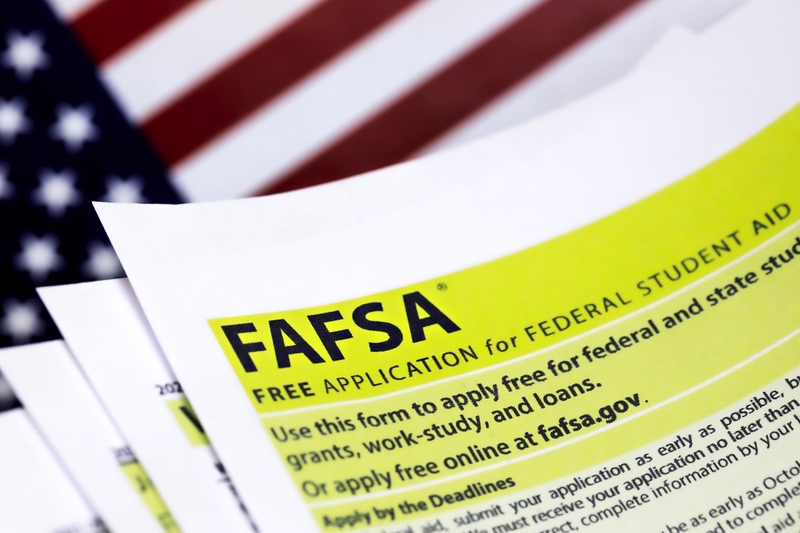The 2024-25 FAFSA® form will be available in December 2023

** ALL** high school seniors and their families should fill out and submit the Free Application for Federal Student Aid (FAFSA). There is NO downside to submitting the 2024-25 FAFSA.
This application determines families’ eligibility for federal grants (money you don’t have to pay back), work-study (where the student has a federally funded job on campus), low-interest student loans, and some scholarships.
Filling out the FAFSA is well worth it. Many parents who thought they earned too much to qualify have been happily surprised by financial aid. While filling out the form doesn’t guarantee need-based aid, the only way to find out if you qualify is to fill out the form.
The 2024-25 FAFSA is available in both English and Spanish at https://fafsa.ed.gov
Important things to know about the 2024-25 FAFSA
To start, the 2024-2025 FAFSA is under revision and will be available “by December 31, 2023.” You’ll want to start filling it out as soon as it becomes available.
For 2024-25, the FAFSA itself was allegedly simplified. The new application makes it easier to import income data from tax records. The Department of Education has also changed its formula to determine which students will qualify for aid and how much they will receive. This change expanded eligibility for federal student aid.
How the FAFSA works
Filing the FAFSA will generate a federal Student Aid Index (SAI). The SAI used to be called the Expected Family Contribution (EFC), and, in essence, delineates how much the family can afford to pay toward the student’s cost of attendance. The determination of need at a given college will be the COA (Cost of Attendance) minus the SAI.
So, the formula is: Cost of Attendance minus Student Aid Index minus Other Financial Assistance equals Financial Need.
COA refers to the total cost for a student to attend a specific college or career/trade school during a school year. The law specifies that COA includes tuition and fees, food and housing, books, and supplies (including renting or purchasing a personal computer), miscellaneous expenses, and transportation. The law also provides allowances for loan fees, dependent-care costs, and expenses for disabled students.
Students and “contributors” must create a Student Aid Account to get an FSA ID before completing the form.
“Contributor” is a new term being introduced on the 2024–25 FAFSA. A contributor refers to anyone who is required to provide their information and signature on the FAFSA, as well as consent and approval to have their federal tax information transferred directly into the form via direct data exchange with the IRS. A contributor may include the student, the student’s spouse, a biological or adoptive parent, and/or the parent’s spouse (stepparent).
Federal tax information will be used to determine the student’s eligibility for federal student aid.
The 2024-25 FAFSA will offer a series of filtering questions that determine which parent of a dependent student will need to be a contributor. It will also identify if there’s another parent whose information must be included on the FAFSA. The information provided by the parent on the FAFSA will determine if a second parent or parent’s spouse will also be a required contributor.
There is federal student aid available for students who cannot provide parent information on their FAFSA due to unusual circumstances.
Requirement for StudentAid.gov Account
Everyone contributing to the FAFSA form online must have their own StudentAid.govaccount. Each contributor, including the student, will access their account with their own FSA ID (account username and password).
The Social Security Administration requires verification of FSA IDs before tax information can be accessed, so applicants need to allow at least three days for this process to be completed. Be sure to start your application as soon as it becomes available!
Importance of the CSS Profile
To determine their eligibility for federal aid, a family must complete the FAFSA. To determine their eligibility for institutional aid (i.e., aid offered by the college itself), a family must file the CSS Profile at https://cssprofile.collegeboard.org/. Many schools that use the FAFSA to determine eligibility for aid (grants, loans, and/or work study) from the government also use the CSS Profile, through which they can determine a student’s eligibility for grants and/or scholarships from the college.
The FAFSA is required from everyone who is seeking financial aid; the CSS Profile is required (in addition to the FAFSA) only by certain colleges. See which colleges require the CSS Profile in addition to the FAFSA at: https://profile.collegeboard.org/profile/ppi/participatingInstitutions.aspx
Some advice when filing for financial aid:
Fill out the FAFSA ASAP
Although the FAFSA deadline for the 2024-25 academic year is not until June 30, 2024, a particular college’s deadline is likely to be sooner. Chances of collecting the maximum amount of FAFSA financial aid diminish as time goes by, as many schools work on a first come, first serve basis when it comes to financial aid. This is why it’s important to meet a college’s financial aid forms deadline.
Report Any Unusual Information
Higher education institutions and the government understand that financial situations can change unexpectedly. Because of that, families have the ability to appeal to a college to adjust their financial aid after submitting the 2024-25 FAFSA. This means if a parent is laid off or facing an expensive medical bill, it should be reported. If earnings reported on a tax return will likely not recur the following year, also make sure the college’s financial aid office knows this. Unexpected money may include a rare bonus or winnings from a game show.
Don’t Inflate Education
Some schools will give applicants “extra credit” if they are considered “first-generation college students.” Given this, parents who never graduated from a four-year college should select “high school” or “some college” as their highest education qualification.
Check and Double Check Everything
Make absolutely sure that no answers are left blank or lines left unsigned. Enter a zero or N/A where appropriate if the question does not apply to you. Make sure everything is spelled correctly and numbers are accurate. Errors will slow the FAFSA process and lower the aid.
Keep Records
When you file any form, keep a copy of the form you are submitting for your records.
More Information and an estimate
For in-depth financial aid information, go to StudentAid.gov.
Use the Federal Student Aid Estimator at https://studentaid.gov/aid-estimator/ to get an early estimate of what your federal student aid could be after submitting the new FAFSA.
Before applying to colleges, we also highly encourage parents/guardians to check the Net Price Calculator at every school on your student’s list. Simply Google the name of the college and “Net Price Calculator.” That is just a starting point. Also, be sure to search “Cost of Attendance” at every college and discuss candidly the colleges’ affordability with your student.
International College Counselors
No matter where your family is in the college admissions process, International College Counselors can help you with every aspect, including brainstorming and applying to alternative college options, writing admissions essays, and preparing for admissions interviews. Call us at 954-414-9986 to discuss how we can support you and your family!

